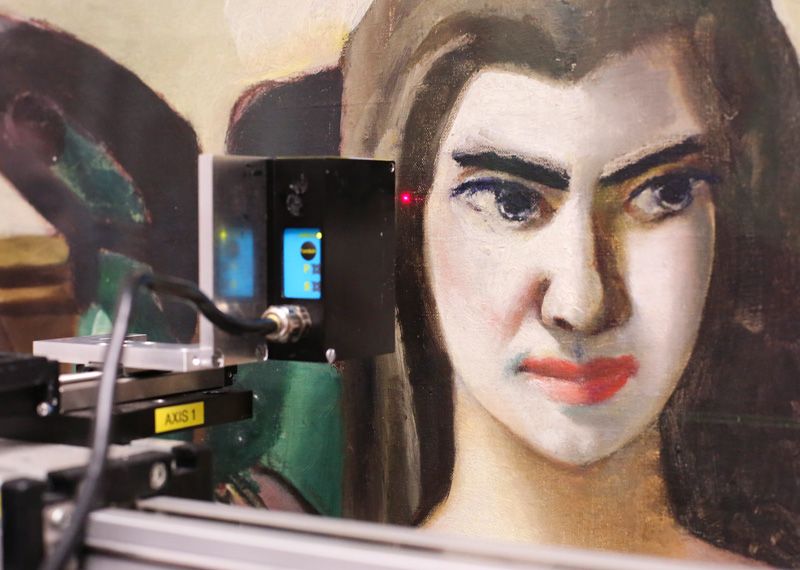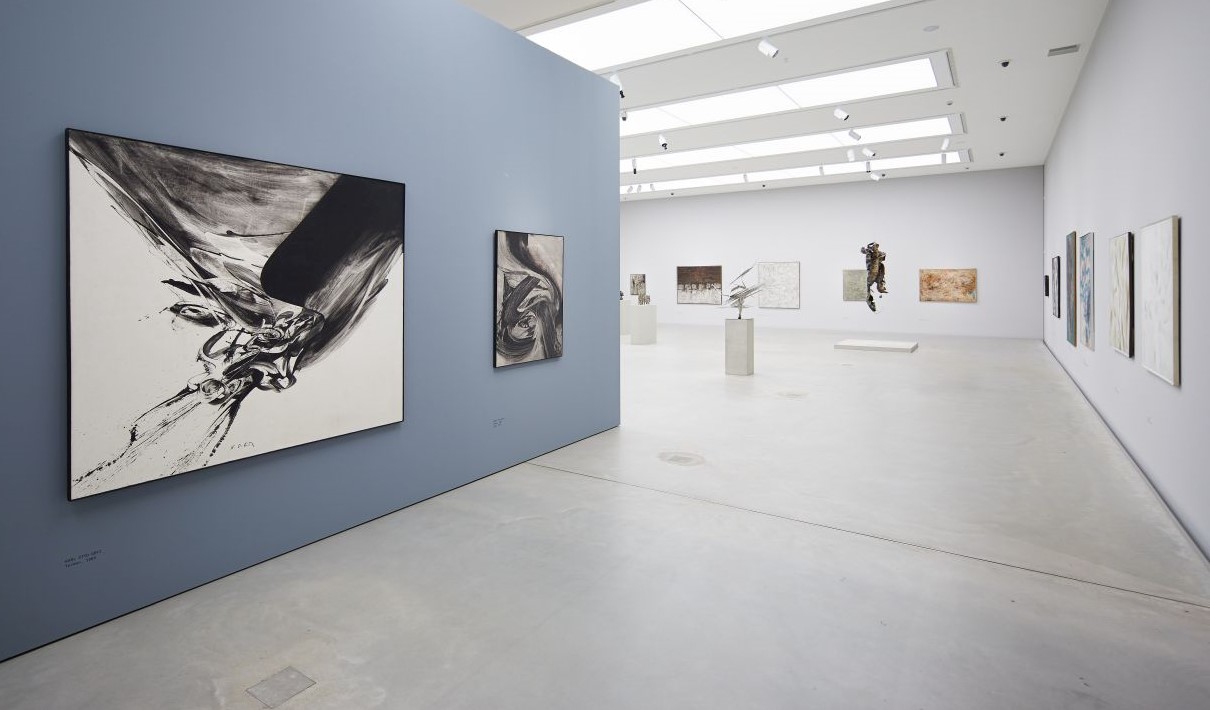Registration
Please contact Saskia Mench to register: saskia.mench@mannheim.de
CONTACT
Saskia Mench
+49 621 293 6253
saskia.mench@mannheim.de
Registration fees
Regular: €120
Students: €40
Friday, June 29, 2018 | 1 pm to 6 pm
1 pm–1:10 pm | Welcome by Dr. I. Herold, deputy director of Kunsthalle Mannheim
1:10 pm–1:15 pm | Introduction to the subject by K. Radermacher, conservator at Kunsthalle Mannheim
1:15 pm–1:45 pm | K. Radermacher, D. Hedinger (independent conservator, Stuttgart) | “The Restoration of Beckmann’s Carnival”
2 pm–2:30 pm | Dr. K. Kracht | “Theory Required! Fundamental of Vibrations, Vibration Loads, and Remedial Measures”
2:30 pm–3 pm | Dr. K. Kracht | “Vibration Investigations of Beckmann’s Carnival”
3 pm | Coffee break in the lobby
3:30 pm–4:30 pm | Practical Session | “Vibration, Works of Art, and Cultural Artifacts”
- Measuring vibrations in paintings Vibrations during different forms of transportation
- Measuring floor vibrations
- Measuring pedestal vibrations
Bruynzeel Storage Systems: “Presentation of Anti-Vibration Products for Preserving Artworks and Cultural Artifacts”
Evening meal at Rheinterrassen Gasthaus am Fluss
Saturday, June 30, 2018 | 10 am to 4 pm
9:30 am | Meet and welcoming remarks
10 am–10:30 am | Dr. W. Wei (Cultural Heritage Agency, Amsterdam) | “The Effect of Vibrations and Cyclical Impact Loads on the State of Objects: Limits and Practical Solutions”
10:30 am–11:00 am | M. Dubus (Institut national du patrimoine, Paris) | “A ‘Vibrational Reference’ for Collections in Transit”
11 am–11:30 am | N. Bäschlin, M. Läuchli (Kunstmuseum Bern) | “Monitoring Vibration During Transport: Implications for Museums”
11:30 am–12 pm | L. Sauvage (Rijksmuseum Amsterdam) | “Transport of Pastel Paintings: Fatigue Damage Due to Vibrations”
12 pm–12:30 pm | Open discussion with speakers
12:30 pm–1:30 pm | Lunch break
1:30 pm–2 pm | A. Johnson (Wiss, Janney, Elstner Associates, Inc. Chicago) | “U.S. Practice in Vibration Control at Museums | Predicting Vibrations Using Preconstruction Testing”
2 pm–2:30 pm | Dr. G. Gülker (Universität Oldenburg): “Good Vibrations | Identifying Cavities in Frescoes Using Digital-Holographic Vibration Assessment”
2:30 pm–3 pm | Prof. T. Kletschkowski (Hamburg University of Applied Sciences) | “Measuring Vibrations of Elastic Continua: The Art of Modeling”
3 pm–3:30 pm | Coffee break and discussion
3:30 pm–4 pm | Group tours of the museum and the restoration workshop
Supported by Bruynzeel Storage Systems

Dr. W. (Bill) Wei
The Effect of Vibrations and Cyclical Impact Loads on the State of Objects: Limits and Practical Solutions
As the number of national and international loans, construction projects, and events in and around museums and other cultural historical institutions grows, so too do concerns about protecting valuable objects and collections from damage caused by mechanical strain such as vibrations and impacts. Questions have therefore been raised about the safe limits of this kind of strain, and the kind of remedial measures that can be taken. In recent years, a growing body of research has sought answers to these problems.
From a scientific point of view, the world of conservation and restoration is primarily governed by chemistry. This makes it rather difficult for many people in the field to follow possible engineering approaches.
This talk introduces fundamental concepts of mechanical strain and how this affects objects. It will also cover simple limits and practical solutions to combat vibrations and cyclical impact loads.
Mr. Arne P. Johnson and Dr. Mohamed ElBatanouny
U.S. Practice in Vibration Control at Museums: Predicting Vibrations Using Preconstruction Testing
Control of vibrations caused by heavy construction in and around museum buildings is critical in order to avoid vibration-induced damage to art objects and fragile buildings elements, where present. In previous publications, the authors described a vibration control methodology they have utilized at numerous museums across the United States. An essential part of that methodology is prediction, well before construction begins, of vibration magnitudes inside the museum. Based on this prediction, the museum can decide where to deinstall or stabilize works of art before construction commences (often an expensive and time-consuming process), or where the contractor may need to restrict construction methods in order to limit transmitted vibrations. This presentation will briefly summarize the overall vibration control methodology and then describe in detail the preconstruction vibration testing and analysis that the authors used to prediction vibrations for three museum construction projects, as well as how well those predictions compared to actual vibration levels measured during the construction.
Leila Sauvage
Transport of pastel paintings: fatigue damage due to vibrations
Pastel paintings are considered as one of the most fragile works of art because the medium is poorly bound to the support. Each handling and transport represents thus a risk of losing pastel agglomerates. In 2014, a collaboration between the Rijksmuseum, the Cultural Heritage Agency of the Netherlands and Delft Technical University was initiated. This research aims at predicting fatigue damage of 18th century pastel paintings subjected to vibrations during transport. This paper discusses important initial results of this study.
Fatigue tests were conducted on mock-ups representative of 18th century pastel portraits. These mock-ups were made using handmade paper and pastel sticks were selected after a technical survey of the Rijksmuseum collection. The fatigue tests were stopped when failure, or unacceptable damage, was reached. The results were plotted as Wöhler diagrams or S-N curves, which relate vibration levels to the number of cycles (duration) to failure.
The first fatigue tests indicate that damage due to vibration is cumulative. The S-N curves obtained are typical for other materials and objects, where pastel mock-ups subjected to high vibration amplitudes reach failure before the ones subjected to lower vibration amplitudes. Further, the results suggest that the properties of the pastel mock-ups, such as the roughness of the support, the morphology of the pastel particles and the presence of fixative, play an important role in the fatigue behaviour for a given vibration environment.
Thomas Kletschkowski
Measuring Vibrations of Elastic Continua: The Art of Modeling
In order to design and implement targeted measures to passively, actively, or semi-actively reduce the occurrence of noise and vibrations, it is helpful to shed light on measured physical phenomena by building models for numerical and non-numerical analysis. This requires precise physical measurements to be taken, described by mathematical models, alongside set system limits, constraints, and the partially idealized dynamic movement of structural elements, in order to efficiently evaluate the value of remedial measures. This talk will explore techniques and applied examples of vibrating lightweight structures, lending an insight into the application of these methods in the analysis of oil paintings.
Dr.-Ing. Kerstin Kracht
Theory Required! Fundamental of Vibrations, Vibration Loads, and Remedial
Everything vibrates. Works of art and cultural artifacts are no exception. But what are vibrations and what causes them? How can vibrations be influenced? This talk concentrates on these key questions, drawing on different methods of portraying vibrations and asking what kind of conclusions can be drawn. This will be followed by an exploration of naturally occurring vibrations and resonance effects. The talk will conclude by looking at measures to control and mediate the impact of vibrations.
Dr.-Ing. Kerstin Kracht
Vibration Investigations of Beckmann’s Carnival
Vibrations can also be helpful. An object’s physical condition determines the way it vibrates. This connection allowed us to develop a method of investigation that uses naturally occurring vibrations to reveal hidden damage. This method was applied to Beckmann’s Carnival both before and after restoration. The results discussed in this talk highlight the importance, use, and necessity of restoration work.
Katrin Radermacher and Daniela Hedinger
The Restoration of Beckmann’s Carnival from 1925
Max Beckmann’s so-called wedding picture has had an eventful history. The large-format painting was damaged by the strain of the multiple journeys it was subjected to as a result of political repression. Extensive restoration work was therefore required. The fact that the canvas had been insufficiently stretched raised questions about the extent to which optimal protection of the rear side of the painting, anti-vibration measures, and glazing can be shown to have a positive impact on the canvas’s vibrational behavior.
Michel Dubus
A "vibrational reference" for collections in transit
Because of the lack of guidelines, it is difficult to evaluate the risks due to vibrations for artworks in transit. Thus, vibrations on traveling artworks were measured with accelerometers from 2011 to 2016, to help understand mechanical hazard occurring during journeys. This constitutes an experimental database that can be used to optimize loan conditions, to specify normal and abnormal shipping conditions, to audit environments of transit and handling practices and to check the performance of the crates. The journey of Olympia in Russia in 2016 illustrates the method.
A paper on this subject has just been submitted for "Patrimoines", the journal of the INP.
Dr. rer. nat. Gerd Gülker
Good Vibrations: Identifying Cavities in Frescoes Using Digital Holographic Vibration Assessment
When looking to preserve historical frescoes, locating and quantifying areas where the plaster has become detached is vital. These sections should be monitored over time. In order to do this in a non-invasive way that does not require a scaffold, a brand-new method has been developed that uses a loudspeaker to apply tiny, sub-microscopic sonic vibrations that expose the cavities in the paintings. Using a specially developed vibration assessment system based on digital holography, these problem areas can usually be automatically and comprehensively detected, before being mapped onto a damage record.
Coauthors: Dr. Klaus Hinsch, Dr. Holger Joost
With our newsletter you will receive regular updates about our exhibitions, program, events, and digital offerings.

